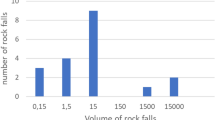Abstract
This study investigates thermally induced tensile stresses in ceramic tilings. Daily and seasonal thermal cycles, as well as, rare but extreme events, such as a hail-storm striking a heated terrace tiling, were studied in the field and by numerical modeling investigations. The field surveys delivered temperature–time diagrams and temperature profiles across tiling systems. These data were taken as input parameters for modeling the stress distribution in the tiling system in order to detect potential sites for material failure. Dependent on the thermal scenario (e.g., slow heating of the entire structure during morning and afternoon, or a rapid cooling of the tiles by a rain storm) the modeling indicates specific locations with high tensile stresses. Typically regions along the rim of the tiling field showed stresses, which can become critical with respect to the adhesion strength. Over the years, ongoing cycles of thermal expansion–contraction result in material fatigue promoting the propagation of cracks. However, the installation of flexible waterproofing membranes (applied between substrate and tile adhesive) represents an efficient technical innovation to reduce such crack propagation as confirmed by both numerical modeling results and microstructural studies on real systems.













Similar content being viewed by others
References
Bühler T, Zurbriggen R, Pieles U, Huwiler L, Raso R (2012) Dynamics of early skin formation of tiling mortars investigated by microscopy and diffuse reflectance infrared Fourier transformed spectroscopy. Cement and Concrete Composites 37:161–170
Felixberger JK (2005) Spannungen im Verbundsystem: Fliese—Verlegemörtel—Untergrund. In: Verein Deutscher Ingenieure VDI (ed) Jahrbuch 2005 Bautechnik. VDI—Verlag GmbH, Düsseldorf, pp 359–390
Gao J, Chung DDL (2002) Damage evolution during freeze–thaw cycling of cement mortar, studied by electrical resistivity measurement. Cem Concr Res 32:1657–1661
Hazaree C, Ceylan H, Wang K (2011) Influences of mixture composition on properties and freeze–thaw resistance of RCC. Constr Build Mater 25:313–319
Herwegh M, Zurbriggen R, Mettier R, Winnefeld F, Kaufmann J, Wetzel A (2015) Hygrical shrinkage stresses in tiling systems: numerical modeling combined with field studies. Cem Concr Compos 35:1–10
Mahaboonpachai T, Kuromiya Y, Matsumoto T (2008) Experimental investigation of adhesion failure of the interface between concrete and polymer-cement mortar in an external wall tile structure under a thermal load. Constr Build Mater 22:2001–2006
Mahaboonpachai T, Matsumoto T, Inaba Y (2010) Investigation of interfacial fracture toughness between concrete and adhesive mortar in an external wall tile structure. Int J Adhes Adhes 30:1–9
Metha PK, Burrows RW (2001) Building durable structures in the 21st century. Concr Int 23:57–63
MeteoSchweiz (2014) http://www.meteoschweiz.admin.ch/web/de/klima/klima_heute.html
Ndon U, Bergeson K (1995) Thermal expansion of concretes: case study in Iowa. J Mater Civ Eng 7:246–251
Passa DS, Sotiropoulou AB, Pandermarakis ZG, Mitsopoulos GD (2012) Thermal and drying cyclic loading for cement based mortars and expanded polystyrene foam layers. Appl Mech Mater 204–208:3648–3651
Sicat E, Gong F, Zhang D, Ueda T (2013) Change of the coefficient of thermal expansion of mortar due to damage by freeze thaw cycles. Journal of Advanced Concrete Technology 11:333–346
Toakley AR, Waters EH (1973) Stresses in ceramic tiling due to expansion and shrinkage effects. Building Sciences 8:269–281
Tonoli GHD, Santos SF, Savastano H, Delvasto S, Mejía de Gutiérrez R, del Lopez de Murphy M (2011) Effects of natural weathering on microstructure and mineral composition of cementitious roofing tiles reinforced with fique fibre. Cement Concr Compos 33:225–232
Weder C (1979) Neuentwickeltes mechanisch-induktives Setzdehungsmessgerät an der EMPA Dübendorf. Material und Technik 2:98–101
Wetzel A, Herwegh M, Zurbriggen R, Winnefeld F (2012) Influence of shrinkage and water transport mechanisms on microstructure and crack formation of tile adhesive mortars. Cem Concr Res 42:39–50
Wetzel A, Zurbriggen R, Herwegh M, Greminger A, Kaufmann J (2012) Long-term study on failure mechanisms of exterior applied tilings. Constr Build Mater 37:335–348
Yiu CY, Ho DCW, Lo SM (2007) Weathering effects on external wall tiling systems. Constr Build Mater 21:594–600
Zentralverband Deutsches Baugewerbe (2005a) Aussenbeläge—Belagskonstruktionen mit Fliesen und Platten ausserhalb von Gebäuden. Merkblatt ZDB
Zentralverband Deutsches Baugewerbe (2005b) Verbundabdichtungen. Merkblatt ZDB
Zurbriggen R, Wetzel A, Greminger A, Kaufmann J, Pass K, Waser H (2009) Outdoor tile damages: a study on critical parameters and characteristic microstructures. Proceedings of the IDMMC two, 30th March 2009, Nuremberg, Germany, pp 18–24
Zurbriggen R, Pass K, Wetzel A (2011) Gut verlegt hält länger. Fliesen und Platten 2:18–21
Zurbriggen R, Herwegh M, Wetzel A (2012) Hygrical stresses in tilings: a combined field, microstructural and numerical modeling study. In: Proceedings of the conference of the chemistry of Construction Materials Division (Fachgruppe Bauchemie, GDCh), Dübendorf, Switzerland, 11–12 Oct 2012, Monographie, 45, pp 103–108
Acknowledgments
We thank Andrea Greminger, Alexander Wetzel (Univ. of Bern) and Monika Stocker (Akzo Nobel Chemicals AG) for support in the acquisition of field data, Josef Kaufmann (Empa) for advice in temperature data logging and Ralph Mettier (Univ. of Bern) for the introduction in numerical modeling with ABAQUS. Financial support by Swiss Commission for Technology and Innovation is gratefully acknowledged (CTI project No 8605.1 EPRP-IW).
Author information
Authors and Affiliations
Corresponding author
Rights and permissions
About this article
Cite this article
Zurbriggen, R., Herwegh, M. Daily and seasonal thermal stresses in tilings: a field survey combined with numeric modeling. Mater Struct 49, 1917–1933 (2016). https://doi.org/10.1617/s11527-015-0623-5
Received:
Accepted:
Published:
Issue Date:
DOI: https://doi.org/10.1617/s11527-015-0623-5




